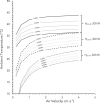Partitional calorimetry
- PMID: 30496710
- PMCID: PMC6397408
- DOI: 10.1152/japplphysiol.00191.2018
Partitional calorimetry
Abstract
For thermal physiologists, calorimetry is an important methodological tool to assess human heat balance during heat or cold exposures. A whole body direct calorimeter remains the gold standard instrument for assessing human heat balance; however, this equipment is rarely available to most researchers. A more widely accessible substitute is partitional calorimetry, a method by which all components of the conceptual heat balance equation-metabolic heat production, conduction, radiation, convection, and evaporation-are calculated separately based on fundamental properties of energy exchange. Since partitional calorimetry requires relatively inexpensive equipment (vs. direct calorimetry) and can be used over a wider range of experimental conditions (i.e., different physical activities, laboratory or field settings, clothed or seminude), it allows investigators to address a wide range of problems such as predicting human responses to thermal stress, developing climatic exposure limits and fluid replacement guidelines, estimating clothing properties, evaluating cooling/warming interventions, and identifying potential thermoregulatory dysfunction in unique populations. In this Cores of Reproducibility in Physiology (CORP) review, we summarize the fundamental principles underlying the use of partitional calorimetry, present the various methodological and arithmetic requirements, and provide typical examples of its use. Strategies to minimize estimation error of specific heat balance components, as well as the limitations of the method, are also discussed. The goal of this CORP paper is to present a standardized methodology and thus improve the accuracy and reproducibility of research employing partitional calorimetry.
Keywords: convection; evaporation; heat loss; heat production; heat storage; radiation.
Conflict of interest statement
No conflicts of interest, financial or otherwise, are declared by the authors.
Figures


References
-
- ASHRAE Thermal comfort. In: ASHRAE Handbook of Fundamentals. Atlanta, GA: ASHRAE, 2009.
Publication types
MeSH terms
LinkOut - more resources
Full Text Sources

